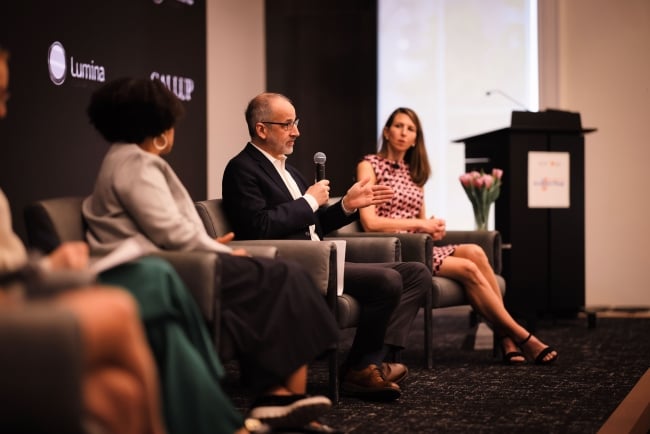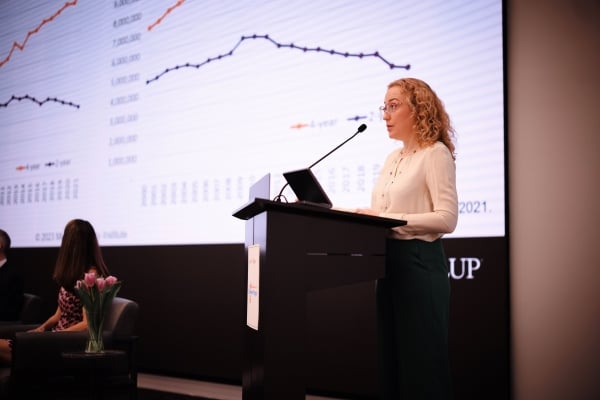You have /5 articles left.
Sign up for a free account or log in.

Doug Shapiro, the National Student Clearinghouse Research Center director, said he doesn’t see enrollments fully recovering from the pandemic nosedive.
Gallup
WASHINGTON, D.C.—Higher ed experts gathered in the nation’s capital Thursday— the day the CDC declared an official end to the COVID-19 public health emergency—to reflect on the damage the pandemic dealt to enrollments across the country and discuss how to rebuild.
The gathering, at a panel series jointly hosted by the Lumina Foundation and Gallup at the pollster’s headquarters a few blocks from the White House, was titled “Bouncing Back From the Enrollment Plunge.” And while the panelists agreed on the depth of the plunge, they were divided on how big a bounce higher ed can muster at the moment—and whether their proposed solutions would boost enrollments to pre-pandemic levels or simply ease the slide to the new normal of reduced head counts.
Doug Shapiro, executive director of the National Student Clearinghouse Research Center, kicked off the day with a summary of his organization’s bleak enrollment and attainment findings since the pandemic began in 2020.
Community college enrollment has dropped by a precipitous 16 percent, he recounted, while four-year institutions have experienced a 4 percent decline. In 2022, the number of undergraduate degree earners fell by 1.6 percent, the first setback for that sector in over a decade. By the end of 2022, the enrollment free fall had slowed to a trickle, but Shapiro said the hole created during the pandemic remains concerningly deep.
While freshman enrollment at four-year institutions rose 4.3 percent last fall—the first year-over-year boost since the start of the pandemic—Shapiro was quick to point out that it’s still 6 percent below 2019 levels.
And while there’s been some recovery among four-year colleges and universities, Shapiro said the vast majority has been concentrated at selective and financially stable institutions. Most small private colleges and regional publics, he said, are still hemorrhaging students—and he’s not sure many of them are going to be able to stop the bleeding.
“In terms of total undergraduate enrollment, [the pandemic] set us back to almost 2005 levels,” Shapiro told attendees. “This fall’s results are a welcome sign, but there’s still a long way to go to get back to pre-pandemic numbers.”
Attendees pointed out some promising trends as well. Nikki Edgecombe, a senior researcher at the Community College Research Center, noted that enrollments at two-year institutions were up by 13.5 percent this spring, driven in large part by a 12.8 percent increase in dually enrolled high school students. That continues the trend of dual enrollment propelling growth at two-year colleges.
Serving a Changing Demographic Base
Looming large over the discussions was fear of a second enrollment cliff somewhere on the horizon, caused by a demographic drop-off that has been predicted for years but remains, the panelists said, largely unaddressed.
Keith Curry, the president of Compton College in California, said many institutions—especially two-year colleges and regional public universities—should prepare for demographic uncertainty by overhauling their approaches to better cater to the populations they will likely serve in the future: nonwhite and nontraditional students.
“These institutions were not built for the student populations we currently serve. They weren’t built for Black and brown students,” he said. “We need to be having conversations across the institution, and between all parts of it, about how best to help these students succeed … All the silos need to be broken.”
Adult learners were a major topic of discussion as a potential bright spot for community colleges and four-year institutions alike. But Jeanne Batalova, a senior policy analyst at the Migration Policy Institute, pointed to a specific subset of those learners who are both underserved by higher ed institutions and eager to enter them: immigrants.

Gallup
“The role of the immigrant origin population, both in the labor market and on college campuses, will only increase in the future,” Batalova told Inside Higher Ed during a post-panel interview.
On the day of the CDC’s pandemic-ending announcement, migrants were already flowing across U.S. borders again. There will be a demographic rise, not a cliff, Batalova said, and institutions should start preparing now for the unique needs of immigrant students and their children.
“The demographics speak for themselves … and yet, while some institutions are aware of how important this is going to be, in most cases people would come to me and say, ‘Wow, really? This is what’s happening?’” she said. “But it’s already happening. Immigrant students are the future, and the future is here.”
Dark Clouds and Silver Linings
Courtney Brown, vice president of impact and planning for Lumina Foundation, closed out the event with a call to action.
“The enrollment plunge is real, and while we are stabilizing, we’re stabilizing at the bottom,” she said. “We may not be hemorrhaging, but we’re still bleeding out … so after today, we need to come together and figure out how to solve this.”
In an interview with Inside Higher Ed, Brown said that despite the stark scenario she painted, she was hopeful—even optimistic—that higher ed could not only bounce back to pre-pandemic levels of enrollment growth but actually exceed them.
“I’m afraid that our expectations are ‘We have leveled out after the decline and won’t recover, and that’s OK.’ I don’t want to see that; I think expectations need to actually be increased,” she said. “We can’t be happy that we’ve leveled out. We need to go beyond even where we were pre-pandemic.”
To get there, Brown said, most institutions will need to seriously reconsider their entire operating model.
“Institutions are going to have to change who and how they serve,” she said. “We cannot do it through traditional-age students.”
Shapiro took a much more pessimistic view. In a post-panel interview with Inside Higher Ed, he said the pandemic merely exacerbated and accelerated the trend of inequity in higher ed, and he wasn’t confident that a shift to serve nontraditional students—even if successful—would be enough to save struggling institutions. That’s bad news primarily for low-income college goers, he added.
“In terms of the four-year institutions, there’s this growing divide between the haves and have-nots … not just the well-funded institutions, but those that have a lot of brand power and ability to attract high-income and high-ability students,” he said. “The most selective institutions are getting stronger, and the smaller privates and regional publics are falling further and further behind.”
Shapiro add there wasn’t much that tuition-dependent institutions could do on their own except pursue downsizing, consolidation and mergers to avoid financial exigency. He sympathized with how frustrating it must be to see the proverbial iceberg ahead but remain powerless to steer the ship away from it.
“We’ve had this historic shift in the balance of who pays for college, from state and local and federal governments onto the backs of students and their families,” he said. “[Institutions] have been forced to adjust their expectations. They haven’t had a choice in the matter.”
When asked what silver linings he saw in the future of higher ed, or how struggling institutions could try to recover their pre-pandemic enrollments, Shapiro stopped and thought for a while. But he came up empty.
“Unless we can get back to a situation where the public is willing to support higher ed,” he said, “I don’t see much reason to hope for that.”









